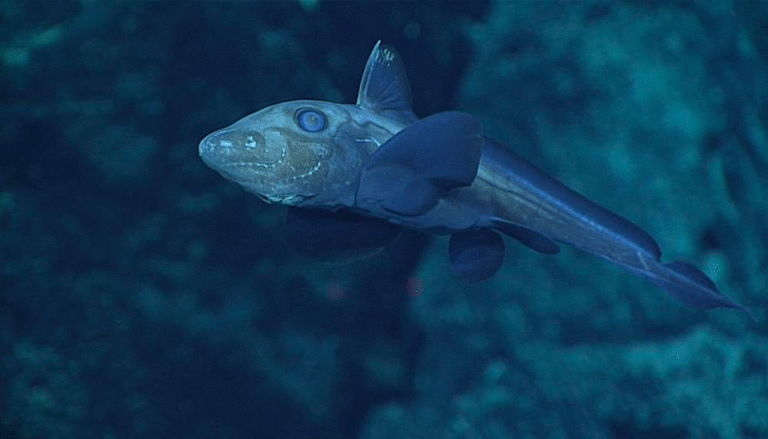A baby ghost shark, officially called a Chimaera, was found in New Zealand, and this scary-looking, dead-eyed fish that live deep in the ocean are rarely seen, previously only photographed alive for the first time in 2009.
Scientists find days-old baby ghost shark
Off the east coast of New Zealand’s South Island, on the ocean floor of Chatham Rise, at a depth of 0.7 miles, scientists from the National Institute of Water and Atmospheric Research made a rare, accidental find, Sky News reported.
While trawling to estimate populations of Hoki fish, they found a newly-hatched, days-old baby ghost shark, its belly still full of egg yolk from its birth. Ghost shark eggs are laid on the seafloor, and the embryos are developed in egg capsules. The embryos feed off a yolk until they are ready to hatch.
Because these fish live in deep water, scientists rarely see them and know little about them.
The first time a live ghost shark was photographed
In 2009, a group of researchers from the Monterey Bay Aquarium Research Institute, who were geologists, accidentally stumbled upon a ghost shark, photographing one still alive for the first time and the first time the creature was spotted in the northern hemisphere, National Geographic reported. The image was captured via a remotely operated vehicle diving of up to 6,700 feet in waters off Hawaii in California. Researchers sought help from experts on chimaeras, who later determined the fish they photographed on video was a pointy-nosed blue chimaera (Hydrolagus trolli). The species are usually found near Australia and New Zealand, according to a study in the journal Marine Biodiversity that wasn’t published until 2016.
Very strange creatures
Scientifically known as Chimaera from the order Chimaeriformes, they go by a number of informal names such as ghost sharks, ratfish, spookfish, or rabbitfish.
Chimaeras are ghostly-appearing creatures with black, dead-looking eyes, hence their nickname. They have smooth, naked-looking skin as they lack plaque placoid scales. They use wing-like fins to “fly” through the water. Their skeletons are composed of cartilage. The color ranges from black to brownish gray. They have a venomous spine in front of the dorsal fin.
The most bizarre feature occurs on male chimaeras, which have retractable sexual appendages on the forehead, a type of tentaculum, and in front of the pelvic fins.
However, chimaeras differ from sharks in a number of ways. They don’t have rows of ragged teeth but munch and grind up their prey instead of using mineralized tooth plates. Also, unlike sharks, their upper jaws are fused with their skulls, and they have separate anal and urogenital openings.
They locate prey via a pattern of open channels on their heads and faces, known as lateral line canals, which contain sensory cells that detect movement in the water.
At least three other species of these fish live in all the world’s oceans except the Arctic and Antarctic.
The closest living relatives to Chimaeras are sharks and rays, although their last common ancestor lived nearly 300-400 million years ago.
According to Wikipedia, these fish typically live in deep water down to about 8,500 feet, with a few living in depths of 660 feet.





